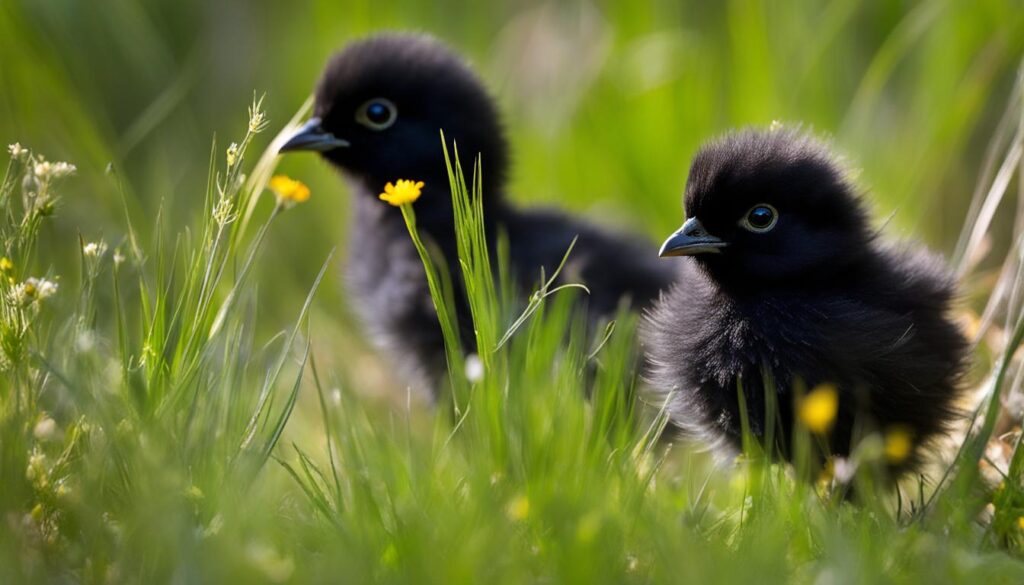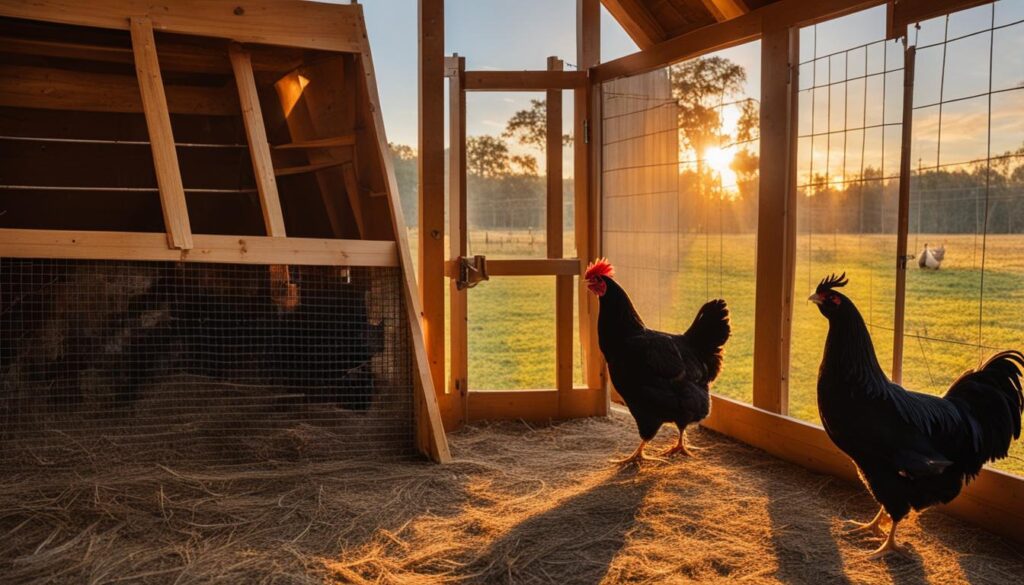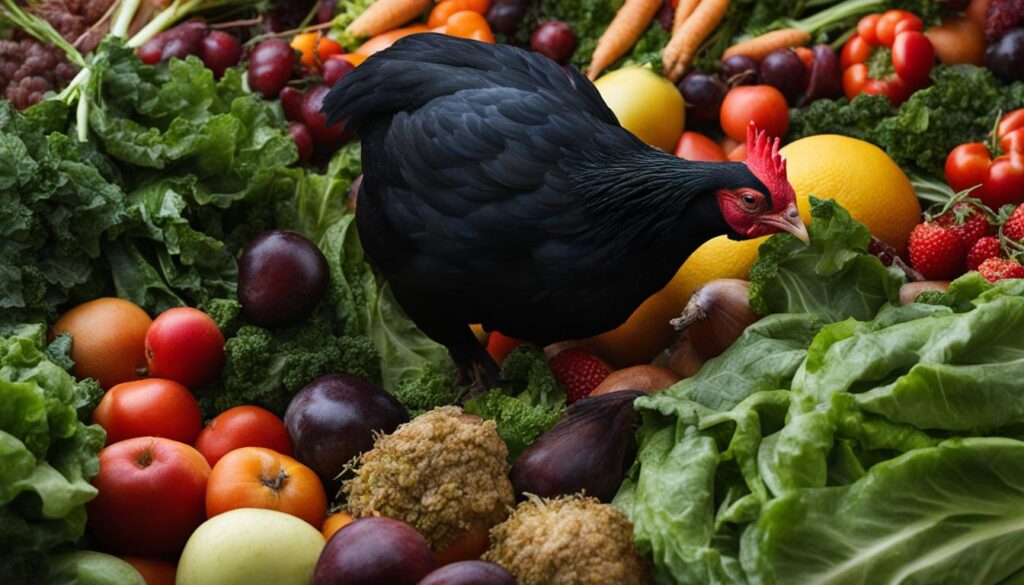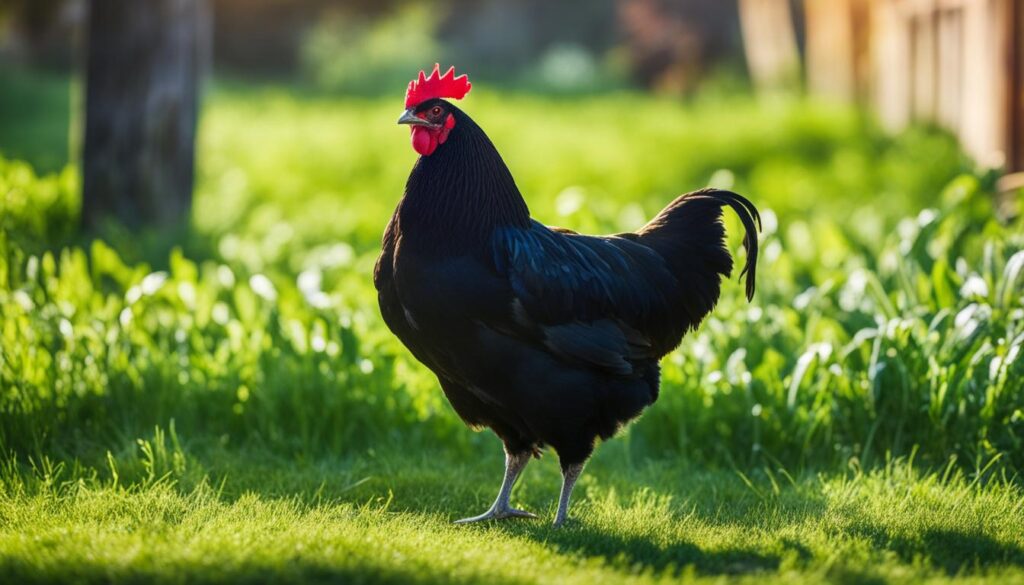As someone who is passionate about backyard poultry and hobby farming, few things bring me greater joy than raising Black Orpington Hens. These beautiful, gentle birds weave their way into your heart, and the satisfaction of seeing them grow and thrive is immeasurable. This guide will serve as your one-stop resource for everything related to raising a flock of healthy, content Black Orpington Hens in your backyard.
I’ll share practical tips on everything from understanding the unique characteristics of this breed to selecting and rearing chicks, caring for pullets, and providing proper nutrition for your hens. Let’s embark on this wonderful journey together and celebrate the joys of hobby farming and backyard poultry.
Key Takeaways
- Understanding the rich history and characteristics of the Black Orpington breed
- Insights into selecting and rearing healthy Black Orpington chicks
- Creating a safe and comfortable brooding area for chicks
- Nutrition tips for optimal Black Orpington hen health and egg production
- Maintaining the well-being of your hens and addressing common health issues
- Best practices for hatching and rearing the next generation of Black Orpingtons
- Integrating eco-friendly, sustainable practices into your backyard poultry farming
Understanding the Black Orpington Breed
Before embarking on your journey to raise backyard chickens, it is crucial to know and appreciate the history and characteristics of the breed you choose. In this section, we will explore the origins of the English Black Orpington and the traits that make them an excellent addition to your backyard farm.
The Origins of the English Black Orpington
The Black Orpington Hen, also known as the English Black Orpington, has a rich and fascinating history. Developed in England during the late 19th century by eminent poultry breeder William Cook, the breed was created by crossing various breeds, including Langshan, Minorca, and Plymouth Rock, to develop the ideal domestic fowl.
Since its inception, the breed has been widely popular among poultry enthusiasts and small-scale farmers globally. Black Orpingtons were introduced to the United States in the early 20th century, where they quickly gained a loyal following for their excellent egg and meat production qualities as well as their attractive appearance.
Fun Fact: Black Orpingtons are named after their dark plumage and the town of Orpington in Kent, England, where they were first bred.
Characteristic Traits of Black Orpington Hens
Black Orpington Hens possess several unique traits, making them well-suited for small farms and backyard settings. Let’s take a closer look at some of these outstanding features:
- Appearance: With their striking black plumage, large size, and well-rounded bodies, Black Orpingtons are an attractive addition to any backyard flock.
- Temperament: Known for their docile and friendly nature, these hens make great companions and are easy to handle, even by young children.
- Egg Production: Black Orpington hens are efficient layers, typically producing 200+ medium to large brown eggs annually, making them an ideal choice for those aiming for a consistent egg supply.
- Meat Production: Due to their substantial body size and impressive weight, Black Orpingtons are also valued as a dual-purpose breed for both egg and meat production.
- Cold Hardy: Thanks to their heavy plumage and good body insulation, Black Orpingtons are well-equipped to handle colder climates and harsh winter conditions.
- Broodiness: Black Orpington hens can be broody, making them excellent mothers to raise their own chicks or even hatch eggs from other chicken breeds.
Given their array of desirable traits, Black Orpington Hens have become a beloved choice among hobby farmers and backyard poultry enthusiasts worldwide.
Selecting Your Black Orpington Chick
Adding Black Orpington Chicks to your hobby farm can be rewarding and enjoyable. However, to ensure the success of your growing flock, it’s vital to choose the right chicks. In this section, I’ll cover the essential considerations when selecting Black Orpington Chicks, from sourcing to health evaluation.

Start your search by researching poultry breeders and hatcheries specializing in Black Orpington Chicks. You can usually find them through poultry clubs or online forums dedicated to hobby farming and backyard chickens. Ensure the breeder or hatchery has a reputation for quality and commitment to the breed’s standards.
It’s always a good idea to visit the breeder or hatchery in person if possible. This allows you to observe the conditions in which the chicks are raised and the overall health of the flock before making your purchase. If visiting isn’t an option, request pictures and detailed information about the chicks before making a decision.
Evaluating the Health of Black Orpington Chicks
When choosing your new flock members, make sure they are healthy and free of any issues. Here’s a checklist to help you identify healthy Black Orpington Chicks:
- Bright and alert eyes
- No signs of respiratory distress (sneezing, coughing, or nasal discharge)
- Clean and dry vent area
- Properly formed beaks and legs
- Active and energetic
- Good weight for their age
Remember, a thriving flock starts with healthy, vibrant chicks!
Choosing the Right Chicks for Your Flock
Consider how many chicks you want to add to your hobby farm and your space limitations. Black Orpingtons are larger birds, so ensure you have the space to accommodate them comfortably.
When selecting chicks, try to choose those within the same age range, as this can help them bond and grow together. An age difference of one to two weeks is generally acceptable. However, introducing chicks with larger age gaps can lead to bullying and stress, especially in a smaller flock.
In summary, selecting the right Black Orpington chicks for your hobby farm means finding a reputable source, choosing healthy specimens, and considering your flock’s overall setup and growth potential. By following these guidelines, you will be well on your way to enjoying the benefits of raising these beautiful, docile birds.
Essential Care for Black Orpington Chicks
Becoming a caretaker for Brooding Black Orpington Chicks requires dedication and knowledge. To ensure a healthy start to their lives, it’s essential to establish a Safe Poultry Environment for the chicks and provide proper feeding for optimal growth. In this section, I’ll guide you through the process of creating the perfect Chicken Brooder Setup and establishing a Poultry Nutrition plan tailored to the needs of your chicks.
Creating a Warm and Safe Brooding Area
Creating an ideal brooding area for your Black Orpington Chicks is crucial, as it directly impacts their growth and overall well-being. Here are the key aspects to consider in a Chicken Brooder Setup:
- Appropriate Temperature: Ensure the temperature is maintained at 95°F during the first week, and gradually decrease by 5°F each week until you reach room temperature or the chicks are fully feathered.
- Heat Source: Use a brooding lamp with a red heat bulb or a radiant heat brooder to provide steady warmth and avoid overheating.
- Space: Give each chick enough room to move, with a standard of at least 2 square feet per chick.
- Bedding: Opt for a non-slip, absorbent material like pine shavings, keeping the bedding clean and dry to prevent mold growth and disease.
- Protection: Provide a secure space that keeps the chicks safe from predators and potential hazards like drowning in water dishes.
Feeding for Optimal Growth and Health
Feeding Black Orpington Chicks the right nutrients is crucial for their Chick Growth and overall health. Here are some tips on Poultry Nutrition:
- Starter Feed: Choose a high-quality starter feed with 18-20% protein content for the first 6-8 weeks of their lives.
- Gradual Transition: Once they reach 8 weeks, slowly transition them to a grower feed with 16-18% protein content.
- Vitamins and Electrolytes: Consider adding a water-soluble vitamin and electrolyte supplement to support their immune system and health.
- Water: Provide access to fresh, clean water at all times. Make sure they can easily reach the water and keep the waterer clean to prevent disease.
By following these guidelines, you can raise healthy Black Orpington Chicks in a warm and safe brooding environment. Cater to their dietary needs by providing them with adequate nutrition, ensuring a smooth start to their lives as vibrant, productive members of your flock.
Transitioning to a Coop: Housing Your Black Orpington Pullet
The exciting time has finally arrived when your Black Orpington Pullet is ready to transition from their brooding area to their new coop home. In this section, I will guide you through the important steps to ensure a seamless coop transition for your pullets and provide information on how to properly prepare their new home.

First and foremost, it is essential to ensure that you have a suitable coop that accommodates your pullets’ needs. A proper pullet housing setup should include ample space, proper ventilation, and protection from harsh weather conditions and predators. Below are the key aspects to focus on when preparing the coop and transitioning your Black Orpington Pullet:
- Plan the moving day by choosing a time when the weather is favorable, and your pullets have fully feathered. Usually, around six to eight weeks of age.
- Ensure that the coop is cleaned and sanitized before you introduce your pullets. This helps to minimize disease transmission and creates a healthier environment for them.
- Inspect the coop for potential hazards such as sharp edges, nails, or insufficient ventilation. Make necessary repairs or adjustments to guarantee a safe and comfortable living space for your pullets.
- Install roosts at various heights to accommodate the growing pullets and accommodate their natural instinct to perch at night.
- A secure nesting area should be provided to allow for privacy and easy egg collection as your pullets mature.
Now that you have prepared the coop, it is important to be patient and allow your Black Orpington Pullets enough time to adjust to their new environment. Introduce your pullets to the coop during daylight hours, granting them time to explore their surroundings and feel secure. Keep a close eye on their behavior and make sure they are comfortable and familiarizing themselves with their new habitat.
| Continuing Care for Your Black Orpington Pullet |
|---|
| Feeding regimen: Continue to provide an age-appropriate diet that meets their specific nutritional needs |
| Observation: Monitor your pullets’ behavior, growth, and health daily, ensuring they are adapting well to their new environment |
| Hygiene: Maintain a clean and sanitary coop by removing droppings, replacing bedding, and scrubbing waterers and feeders regularly |
| Protection: Check fencing, latches, and coop structure for potential security risks and repair promptly to keep your pullets safe from predators |
Transitioning your Black Orpington Pullet to a coop is a pivotal moment in their life cycle. Investing time and effort in preparing the coop will go a long way in ensuring their maximum comfort, safety, and overall well-being. Your diligent care and commitment to their happiness will be rewarded with a thriving and content flock of Black Orpington Hens.
Nutrition and Diet: Feeding Your Black Orpington Hen

As a Black Orpington Hen owner, it’s important to provide a balanced diet that is tailored to their specific nutritional needs. This not only promotes overall health and well-being, but also ensures robust egg production and allows your hens to live a long and healthy life. In this section, we will delve into the nutritional requirements of your Black Orpington Hens, and discuss how to select the appropriate chicken feed to meet their needs.
Understanding the Nutritional Needs
Black Orpington Hens, like all chickens, have specific dietary needs that must be met in order for them to thrive. A well-rounded diet should consist of a proper balance of proteins, grains, and greens. Protein is vital for growth, feather development and egg production, while grains provide the necessary energy and fibers, and greens supply essential vitamins and minerals. The table below outlines the approximate daily nutritional needs of a Black Orpington Hen.
| Nutrient | Amount (grams/day) |
|---|---|
| Protein | 16-18 |
| Grains | 50-60 |
| Greens | 20-30 |
Meeting these poultry nutrition needs promotes good health and supports their ability to produce quality eggs. It’s also essential to provide fresh water at all times to maintain proper hydration.
Choosing the Right Feed for Your Hen
With a clearer understanding of the nutritional requirements of your Black Orpington Hen, you’re better equipped to select the right feed. When it comes to chicken feed selection, it’s important to look for high-quality products that cater specifically to the needs of your backyard chickens.
Opting for an organic poultry diet is a beneficial choice, as these feeds tend to be more nutritionally dense and free from synthetic additives, pesticides, or genetically modified ingredients. Additionally, organic feed suppliers often prioritize sustainable farming practices, which is a huge plus for environmentally conscious hobby farmers.
You may also consider preparing your own homemade chicken feed, which allows you to customize the ingredients and tailor the mix to your Black Orpington Hen’s dietary needs. Be sure to consult with a poultry nutrition expert to ensure a proper balance of proteins, grains, and greens in your customized feed.
- Look for high-quality commercial feeds that cater to Black Orpingtons or other backyard chickens
- Opt for organic poultry diets to provide your hens with nutritionally dense feed
- Create a balanced homemade feed with the help of a poultry nutrition expert
“You are what you eat” – this especially rings true for your backyard Black Orpington Hens! A nutritious and diligently chosen diet ensures their overall well-being, enriches egg quality, and contributes to the longevity of your flock.
With this knowledge of Black Orpington Diet and poultry nutrition needs in hand, you’re well on your way to raising healthy, happy, and productive hens. Remember to pay close attention to your flock’s diet, regularly reassess their nutritional needs, and don’t hesitate to consult experts to ensure you’re providing the best care possible for your backyard chickens.
Health and Wellness: Keeping Your Black Orpington in Top Condition
As with any other breed of poultry, your Black Orpington Health is of paramount importance. In this section, I’ll share some practical tips for monitoring and maintaining the health of your Black Orpington Hens. We will discuss common health issues that may arise, preventive measures, and when to seek professional veterinary care to ensure a vibrant and productive flock.

“An ounce of prevention is worth a pound of cure.” – Benjamin Franklin
Here is a list of common health issues Black Orpington Hens might face, along with possible prevention methods:
- Worms: Regularly deworm your flock using medications available through your veterinarian or local pet store. Maintain a clean coop, avoiding dampness and build-up of feces that can create a breeding ground for parasites.
- Mites and Lice: Keep the coop clean and dust your hens with an approved insecticide powder to prevent infestations. Inspect your birds regularly for any signs of mites or lice.
- Respiratory Issues: Proper ventilation is critical in the coop to prevent respiratory ailments. Promptly address any symptoms of sneezing, coughing, or discharge from the eyes or nostrils.
- Injuries: Provide proper roosting spaces and perches at a suitable height to prevent injuries from jumps or falls. Regularly inspect your hens for signs of injury or abnormal behavior.
Here are some best practices to ensure ongoing Poultry Wellness:
- Perform regular flock health checks.
- Ensure clean and fresh water is available at all times.
- Feed quality, nutritionally-dense food to support growth and development.
- Maintain a clean and ventilated coop environment.
- Provide safety measures to protect your flock from predators.
Occasionally, despite your best efforts to promote Chicken Care, your hens may develop a health issue that requires veterinary intervention. It is essential to have a trusted avian veterinarian available to provide professional guidance and treatment when necessary.
In conclusion, keeping your Black Orpington Hens in top condition requires consistent monitoring, preventive measures, and a commitment to cleanliness. These practices will ensure your hens’ health and contribute to a thriving, productive flock.
Hatching and Rearing Chicks: The Life Cycle of Black Orpingtons
Creating the next generation of your Black Orpington flock entails two main phases: incubating the eggs and rearing the chicks. In this section, we will explore the best practices for incubating Black Orpington eggs, effective incubation techniques, and raising healthy, thriving chicks.
Incubation Best Practices
Incubating Black Orpington eggs is an essential and delicate stage in the poultry reproduction process. For a successful hatch, consider the following guidelines:
- Temperature and Humidity: Maintain a consistent temperature of 99.5°F (37.5°C) when using a forced-air incubator, or 101.5°F (38.6°C) for still-air incubators. An optimal humidity range is between 45-55% for the first 18 days, increasing to 60-70% during hatching.
- Egg Turning: Turn the eggs at least three times daily until 18 days of incubation. This helps prevent embryo attachment to the eggshell and promotes healthy development.
- Hatching Success: Observe signs of a successful hatch – pipping (a small crack or hole in the shell), peeping (soft chirping sounds), and finally, emergence of the chick from the shell.
Raising the Next Generation of Black Orpingtons
Rearing Black Orpington chicks involves long-term care strategies that ensure a sustainable and productive flock for years to come. Consider these key stages through the poultry life cycle:
- Newly hatched chicks: Transfer the chicks to a warm, safe brooder environment, with a temperature of 95°F (35°C) during their first week of life. Gradually decrease the temperature by 5°F (3°C) per week until they are ready to move to the coop.
- Feeding: Provide high-quality chick feed, with 20-24% protein content and essential nutrients for optimal growth. Maintain clean and fresh water availability at all times for hydration.
- Developing into pullets: Monitor the chicks as they transition from fluffy babies to adolescent poultry. Keep an eye on their health and well-being. Provide age-appropriate feed and supplements to foster continuous growth.
- Toward maturity: By weeks 18-22, your young Black Orpingtons will transition to their adult lives. Switch them over to a layer feed, which promotes egg production and sustains them throughout their reproductive years.
With diligence and foresight in incubating and rearing your Black Orpington chicks, you can foster the growth and prosperity of your next-generation flock. This careful process can add years of fulfillment and joy to your hobby farming experience.
Integrating Sustainability: Eco-friendly Practices for Your Flock
As a passionate hobby farmer, I believe in the importance of incorporating sustainable and eco-friendly practices into our daily routine. In this final section, I would like to share some innovative ideas that can help you transform your backyard poultry venture into a more sustainable endeavor, harnessing the endless possibilities of green living and eco-friendly poultry farming.
One of the first steps towards creating a sustainable environment for your Black Orpington flock is adopting a waste reduction mindset. There are numerous opportunities to recycle and repurpose waste products that your hens create. For instance, chicken manure is an excellent source of organic fertilizer, rich in nitrogen and other essential nutrients, and can be applied to your garden or compost pile. In addition, consider using biodegradable bedding materials like straw, hay, or shredded newspaper to further minimize waste and simplify the cleanup process.
Another key aspect of sustainable Black Orpington care is the responsible sourcing of chicken feed. Prioritize organic and locally-produced feed, which is not only better for your hens’ health but also reduces your carbon footprint. Look for environmentally-friendly bagging options, such as recycled or compostable packaging, which help minimize plastic waste. To further promote sustainability, consider planting a small garden to grow some of your hens’ favorite greens, herbs, and grains, thereby reducing your reliance on store-bought feed.
In conclusion, adopting eco-friendly practices benefits not only your Black Orpington flock but also the environment. As you embrace these sustainable habits, you will enjoy the satisfaction of knowing that your hobby farm is making a positive impact on the world around you. With a conscious focus on green chicken raising, you can help preserve our planet while still reaping the rewards of a thriving, productive flock.
FAQ
What is the typical temperament of a Black Orpington Hen?
Black Orpington Hens are known for their docile, friendly, and easily-handled nature, making them an excellent choice for small-scale farms and backyard poultry enthusiasts.
How can I choose a healthy Black Orpington Chick for my flock?
Look for chicks that are lively, have clear eyes, and clean vents. Also, consider purchasing from reputable hatcheries or breeders to ensure you are obtaining quality Black Orpington Chicks.
How can I ensure a smooth transition for my Black Orpington Pullet from the brooder to the coop?
Gradually introduce your pullet to the coop by allowing them to explore during the day and returning them to the brooder nights until they are comfortable in their new environment. Providing proper ventilation, clean bedding, and easy access to food and water in the coop can also aid in a smooth transition.
What are the nutritional requirements of a Black Orpington Hen?
To maintain optimal health, Black Orpington Hens require a balanced diet rich in proteins, grains, and greens. Depending on individual feed choices, this may include layer feed, scratch grains, and various dietary supplements.
What are some common health issues to look out for in Black Orpington Hens?
Common health issues in Black Orpington Hens include respiratory infections, parasites, egg-laying problems, and obesity. Regular inspections, preventive measures like proper coop hygiene, and prompt veterinary care when needed can help maintain your hens’ health.
How can I practice sustainable and eco-friendly poultry farming with my Black Orpington Hens?
Sustainable practices for raising Black Orpington Hens include using renewable resources, recycling waste, and incorporating environmentally friendly feed options. These practices not only benefit the environment but also the overall health of your flock.
